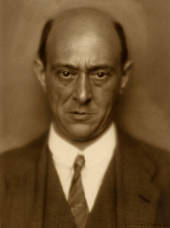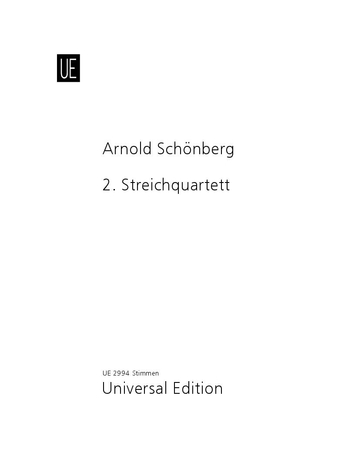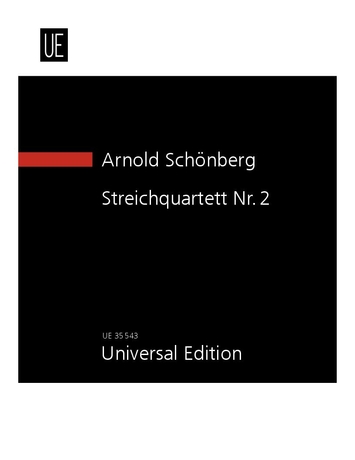

Arnold Schönberg
String Quartet II
Duration: 30'
Text von: Stefan Anton George
Klavierauszug von: Alban Berg
Solos:
soprano
Instrumentation details:
1st violin
2nd violin
viola
violoncello
Schönberg - 2. Streichquartett for soprano and string quartet
Translation, reprints and more

Arnold Schönberg
Schönberg: String Quartet No. 2 F# minor for soprano and string quartet - op. 10Orchestration: for soprano and string quartet
Type: Taschenpartitur
Language: Deutsch

Arnold Schönberg
Schönberg: String Quartet No. 2 F# minor for soprano, 2 violins, viola and cello - op. 10Orchestration: for soprano, 2 violins, viola and cello
Type: Stimmensatz
Language: Deutsch

Arnold Schönberg
Schönberg: String Quartet Nr. 2 F# minor for soprano and string quartet - op. 10Orchestration: for soprano and string quartet
Type: Studienpartitur
Language: Deutsch
Audio preview
Work introduction
Performance Instructions from the end of 1909
In the possession of Albi Rosenthal, Oxford, is a copy of Ea (refers to this version of the score), in which Schönberg entered a large number of metronome markings and more detailed instructions for the performance*. The document is self-bound, and in order to make space for entries, Schönberg inserted 28 x 10.5 mm wide (approximately) strips of paper at the outer edge of each page of the book block that overhangs the sides by about 9 cm. Entries are written mainly in red ink and red pencil.
The performance instructions are in direct relation to a Paris performance of the string quartet planned by Jules Écorchville (1872-1915), the prominent French musicologist and editor of Revue Musicale de S.I.M.**. Schönberg, who became aware of the performance through Egon Wellesz, placed such importance on this performance that he not only provided a score, but also prepared performance instructions, which Wellesz sent to Écorchville. In a postcard dated December 13, 1909 (also owned by Albi Rosenthal), Wellesz writes: I send here a study score of the quartet of A. Schönberg. The many metronome markings should not confuse the players. They serve often only to make an accellerando [sic!] understandable if the players are not quite in agreement about the tempo. I hope for the best success for the Schönberg performance, Schönberg thanks you very much for your kindness.
After the death of Écorchville the score came into the ownership of the music scholar Henry Prunières (1886-1942), who re-founded the Revue Musicale in 1920. The owner’s mark HPrunières is on the recto side of the endpaper. Albi Rosenthal acquired the score around 1950 from the family Prunières. He has made accessible to the Gesamtausgabe not only the available sources in his possession, but supported the present publication of Schönberg's performance instructions also through his own transcription. The performance instructions are completely outside of the traditional context of other related sources. The scores and notes are a rarity within Schönberg’s surviving manuscripts. He never commented on a work in such a detailed way, neither offered similar notes for another performance of the Second String Quartet. One can therefore assume that Schönberg’s instructions refer solely to this special event and not regarded as obligatory emendations to the score notes of the quartet. In the following list, in the absence of an immediate indication of where the beat is, it is meant to be the beginning of the measure. The formula “in margin” or “to those in margin” indicates the duplication of reference characters in the sidebar.
Early general observations
Title page in margin
above:
Note: the first 4-6 strokes of the Metronomes are usually too quick. Only after the 5th-6th beat [Correction results for beats 6-7] does the metronome become calm and regular.
below, running vertically from top to bottom:
The metronome markings must not be regarded as the absolute indication of the tempo. Although they are very carefully tested, errors are still very likely. [paragraph] But they might give a picture of the relationships of the tempos and express especially reasonable ritardandi and accelerandi.
First music page top left side in margin
Accel. and rit. are sometimes specified with numbers. These are to be viewed only [inserted] as incidental and achieved through consistent accelerating or decelerating the tempo.
Translation: Stacie Dunlop
* See Ruffer J: The Works of Arnold Schönberg, London 1962, page 30, as well as Egon and Emmy Wellesz: Egon Wellesz Life and Work, ed. F. Endler, Vienna / Hamburg 1981, pp. 65f.
** In this journal in 1912 appeared a facsimile of the III. Movement, see page 139.
